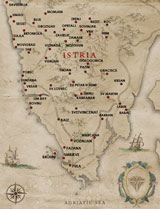to enlarge


or choose the place
from the menu below
 Rome |
 Byzantium |
 Venice |
 Vienna |
 Brioni |
 Smrikve |
 |
 |
In 1508 and in 1511 Venetians occupied Racice. From 1521 Racice was part of Venetian dominions in Istria but the family Walderstein remained to rule over the feud. This happened because the wife of Cristoforo Walderstein was from a Noble family Dell’Argento from Trieste and the Walderstein family swore the loyalty to the Venetian Republic.
Walderstein remained in charge of Racice feud until the fall off Venice Republic and the successors of this family continued to own the palace until the end of the second World War.
After the fall of Venice the village followed the history of other Istrian towns and villages. After a short period of Austria and Napoleon rule it became part of the Austrian Empire and later on the Austro-Hungarian Monarchy until the end of the First World War. Between the two World Wars the village was part of Italy and after the Second World War became part of Yugoslavia (Croatia).
During the Italian Fascist period in Istria many Istrian families suffered from the regime or had to leave Istria. Fascism in Istria applied various repressive measures mostly towards Slav populations and this created the Antifascist Movement. The Second World War was a very painful experience for the Istrian population and many innocent Istrians, both Slav and Latin, died during that war.
After the second World War Racice became part of Yugoslavia (Croatia). There were three agreements between Yugoslavia and Italy which established that Istria would become a part of Yugoslavia: Paris Agreement of 1947, London Memorandum of 1954 and the Osimo Agreement reached in 1975. In the first decade after the Second World War many Istrians, especially those living in towns and villages that for centuries were part of the Venice Republic, decided to leave Istria.
In 1991 with the fall of Yugoslavia and the founding of the Republic of Croatia, the internal republic boundaries were recognised as the state boundaries and Racice is today part of Croatia.
In 2013 Racice became part of the European Union. You can not change the past but you can try to learn from it. The main aim of the European Union founders was to build a system that could avoid future wars and future refugees in Europe as I explain in COSMOPOLITE.